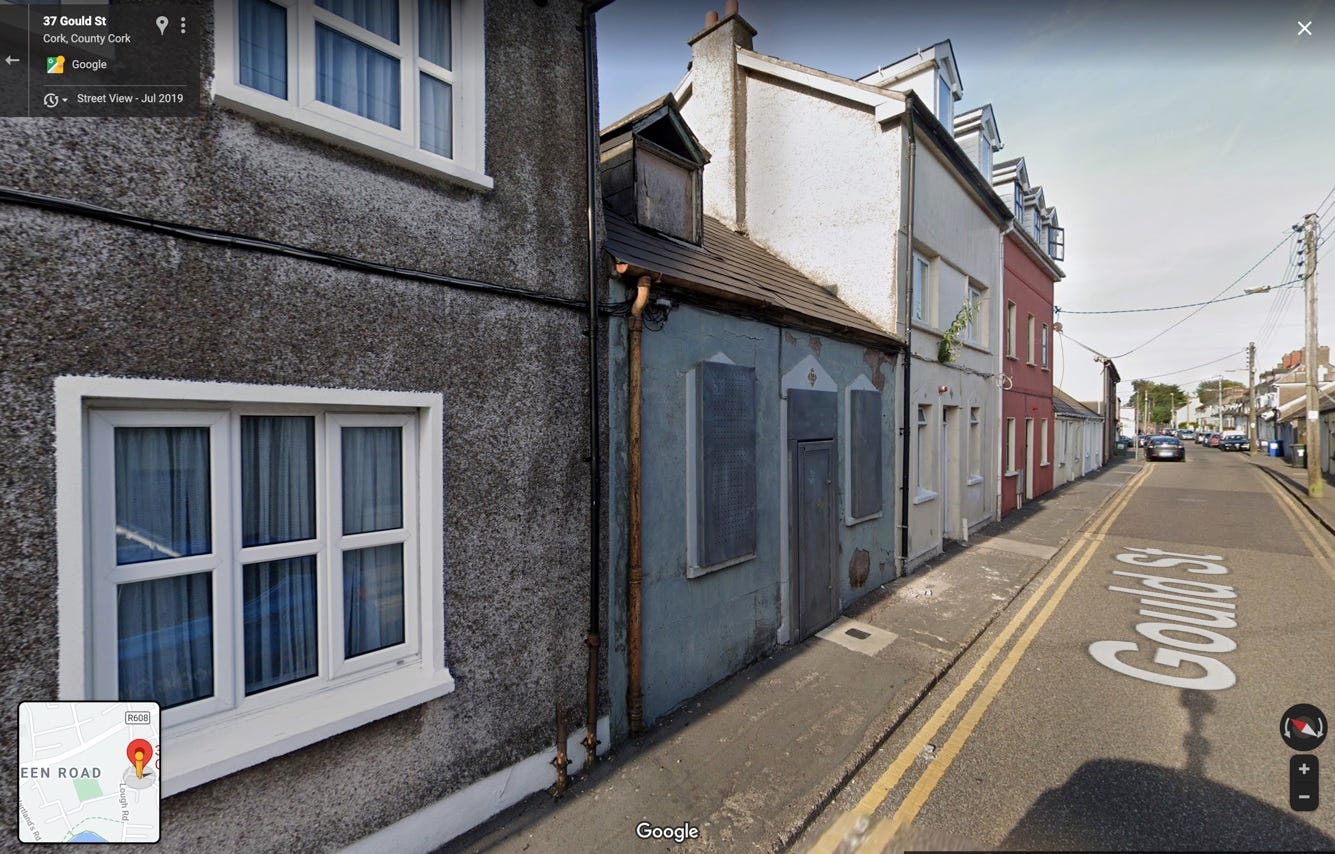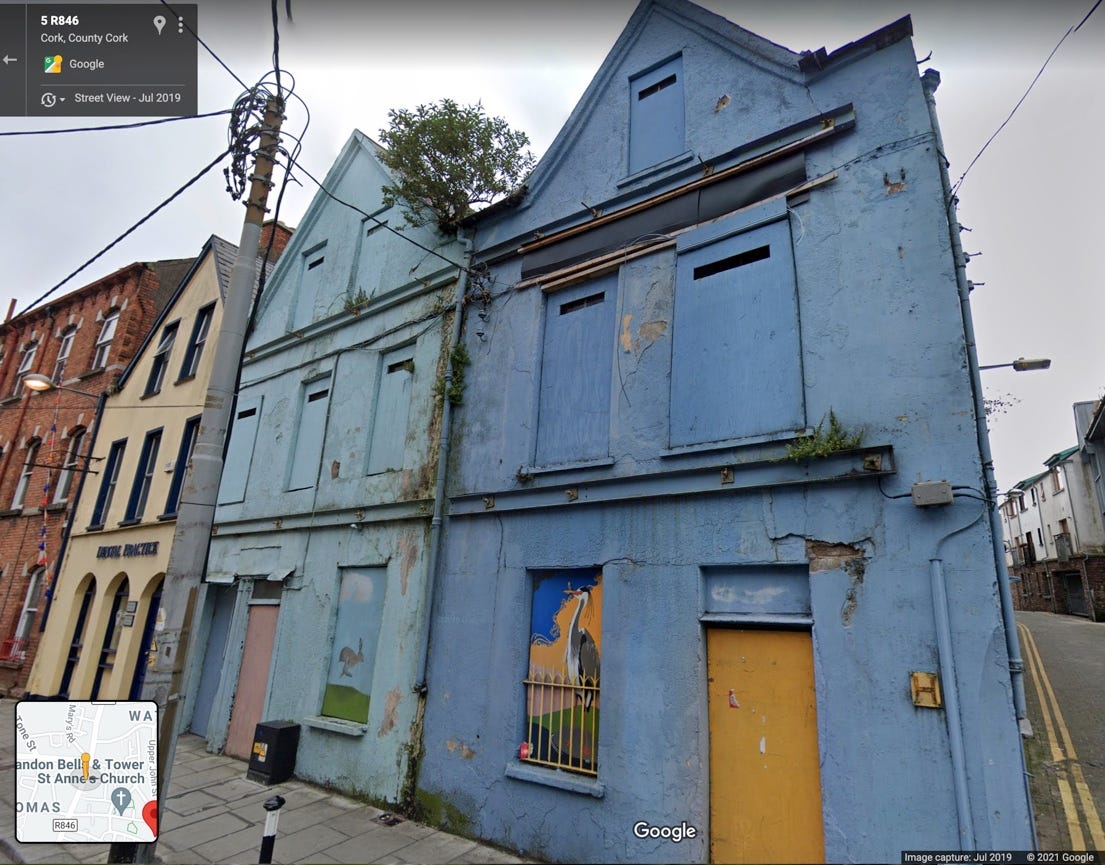Who is the biggest owner of derelict sites in the city?
One entity owns 14% of the properties on Cork City Council's derelict sites register.
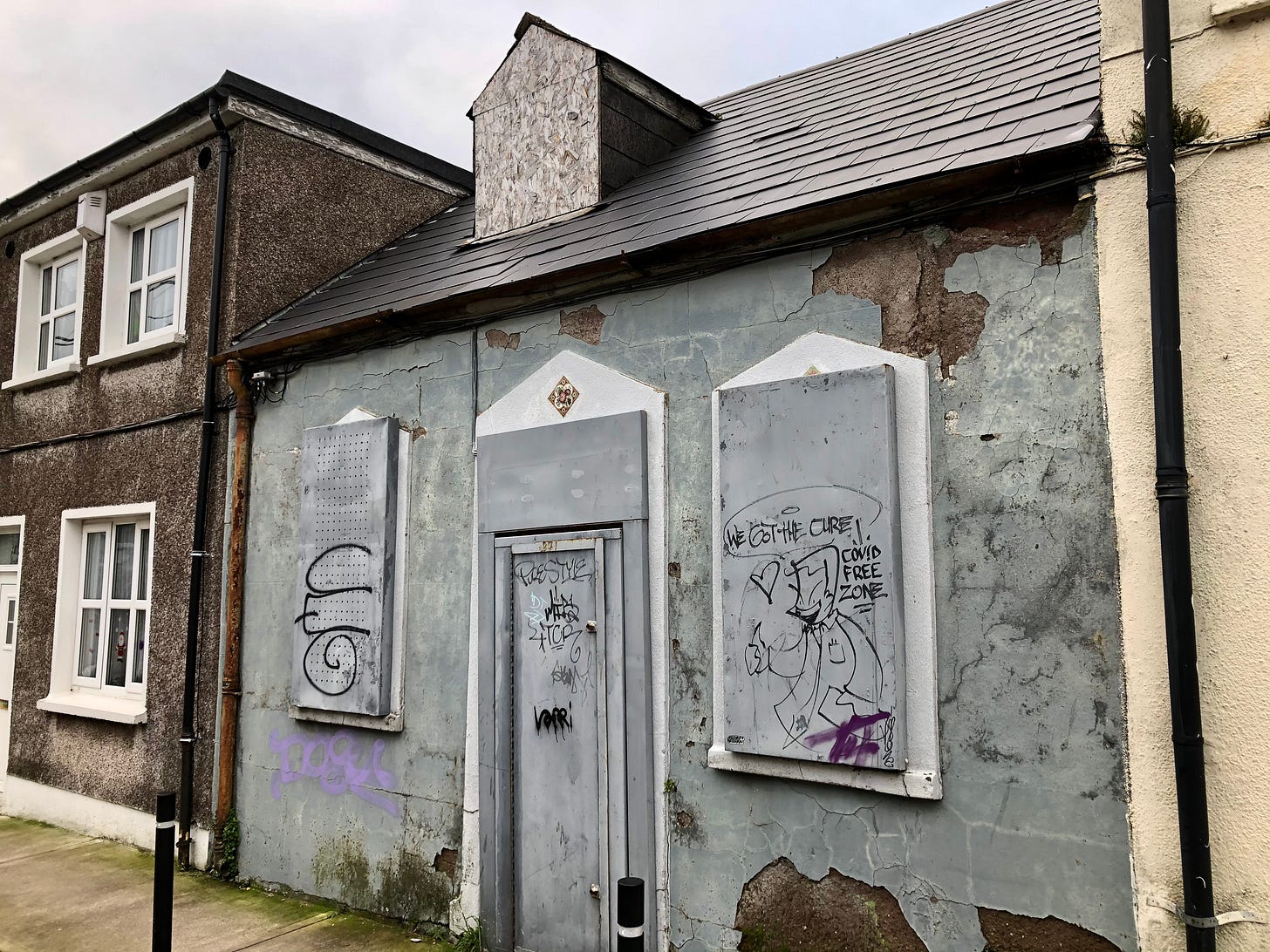
Did you guess it?
Surprise surprise: this entity is Cork City Council itself.
That’s right, 13 of the 93 properties listed on Cork city’s derelict sites register this year are owned by the local authority. This makes Cork City Council arguably the single biggest owner of properties on the derelict sites register in the city.
Most of these properties have been derelict and in council ownership for more than three years.
In fact, excluding Glasheen House described below, which is due to come off the register, these houses have been derelict for a combined total of 113 years up until the end of 2021: an average of nine and a half years per property.
Here is the full list of the council-owned properties on the 2021 Derelict Sites Register:
Glasheen House, Dorgan’s Road (registered derelict in 2015, acquired by Cork City Council in 2017, recently renovated and due to come off the register)
6A John Redmond St (on derelict register since 2008)
7 John Redmond St (on derelict register since 2008)
96 North Main St (on derelict register since 2015)
52 Barrack St (on derelict register since 2017)
38 Gould St (registered derelict since 2012, acquired by Cork City Council in 2018)
2 Árd na Rí Avenue, Pouladuff (registered derelict in 2015, acquired by Cork City Council in 2017, to be kept by council as a decanting property)
A site next to 34 South Main St (on derelict register since 1998)
1 Evenus Ville, Albert Road (on derelict register since 2016)
15 Lough View Terrace, Glasheen Road (registered derelict since 2012, acquired by Cork City Council in 2018)
Wyndern, Pope's Road (on derelict register since 2016)
44 Cornmarket St (on derelict register since 2003)
Site number 2 at Kyrl's Quay (on derelict register since 2017)
Compulsory Purchase Orders
Of course, unlike other owners of Cork’s derelict sites, Cork City Council have acquired these properties with the express purpose of making improvements to our cityscape and housing stock, so maybe it is only to be expected that they own such a large proportion of them.
They aren’t, after all, land hoarding for profit or using dereliction to push for consent for unsuitable developments.
However, the often lengthy delays in progressing these derelict houses back into use as homes, especially in the current highly pressured housing market when the demand for both social housing and private rentals is not being met, is worth examining.
When it comes to dereliction, one of the criticisms most often levelled at local authorities is that they don’t use Compulsory Purchase Orders (CPOs) aggressively enough.
There’s a growing public demand for tougher measures to combat the depressing scourge of dereliction and the impact that the sight of crumbling and neglected houses, seemingly unwanted, is having on those who may be themselves struggling to pay rent or living in insecure accommodation and yearning for a home of their own.
The Derelict Sites Act 1990 allows local authorities to compulsorily purchase derelict sites with the permission of An Bórd Pleanála: they pay the owner market value for the property, which the owner is legally bound to accept.
A lot has changed since 1990 and there’s an increasing emphasis on CPO for local authorities to activate stagnant housing stock, either through refurbishments and the provision of social housing, or through selling on CPOed properties into the private market; this is seen as a solution to long-term dereliction when owners either can’t or won’t take responsibility for stopping their own buildings falling into disrepair.
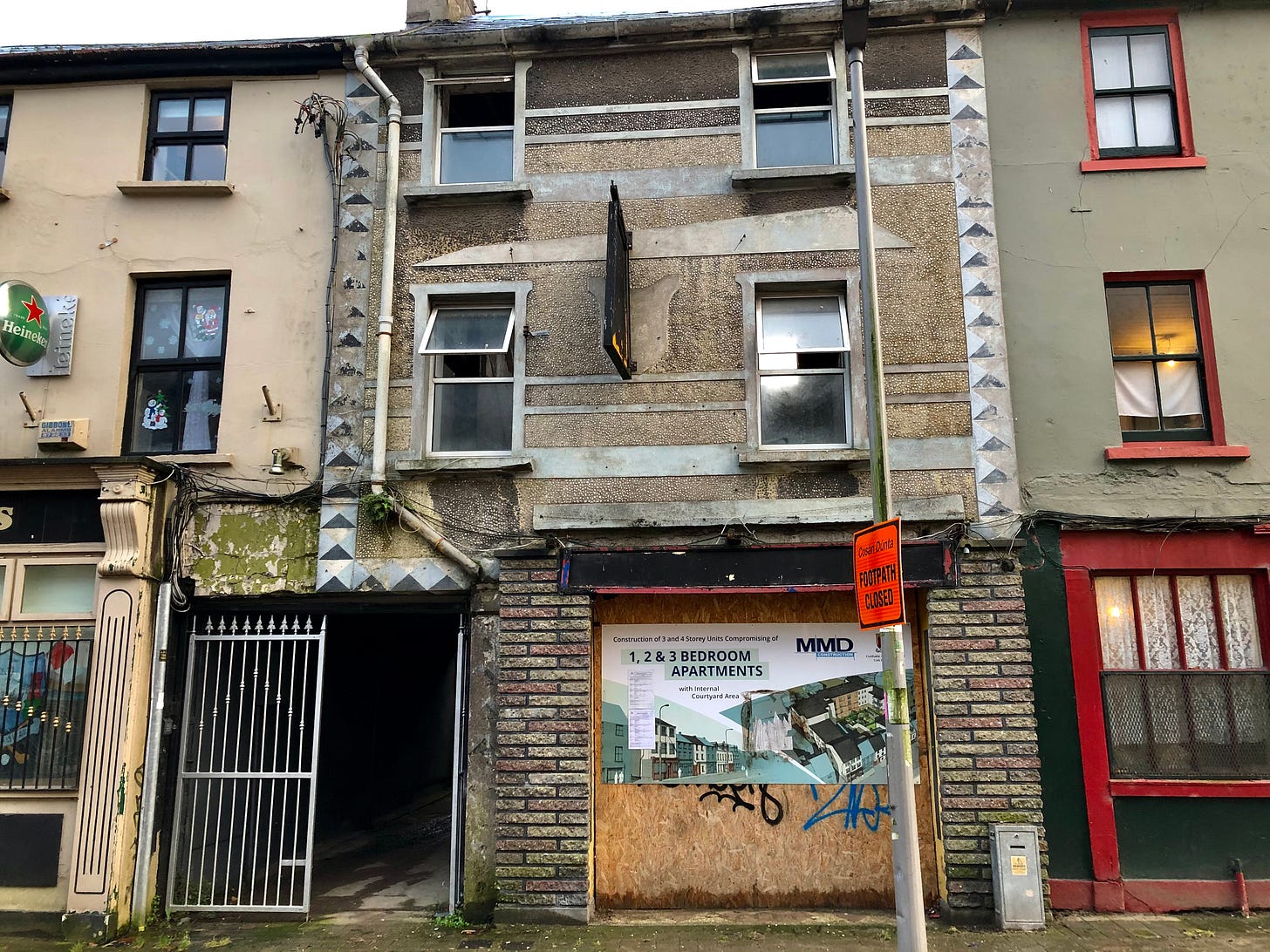
A massively ambitious target of 500 vacant houses to be acquired by councils nationwide each year until 2026 is one of the aims of the government’s “Housing For All” plan published by the Department of Housing, Local Government and Heritage in September.
But public frustrations with what seems like the snail’s pace of the CPO and refurbishment process is mounting and calls for a “use it or lose it” approach are getting louder.
“There’s a push on to deal with derelict sites and vacancy and it’s very important that there’s public engagement, because it does raise the profile of what is a very important issue,” Niall Ó Donnabháin tells me.
Niall is the recently appointed Director of Housing with Cork City Council. He previously held a position in the Planning Directorate, with a brief intervening stint with Cork County Council.
The Derelict Sites Register is managed by the council’s Planning Department, but the Housing Department works with them on restoring derelict properties to use.
“The Housing Department, under my stewardship, is going to continue to play an active role in removing dereliction, on our own property but also on a wider basis and beyond the register,” Niall says.
“What I can say is that now, there is a much larger and more active team dealing with derelict sites. It’s much more streamlined when it comes to trying to encourage owners to develop a property. If there’s no action and no engagement, and no reason for it to be in the state that it’s in, we’d be looking to move much more swiftly to put it on the register.”
Not so simple
But when it comes to the creakingly slow progress on some properties - below read our case study of two properties whose owner passed away in 2002 - Niall says the public may not be aware of the complex legal process undertaken by the council with each of these houses.
“Yes, absolutely, the timeline in some cases is significant,” he says.
“But behind every derelict site there’s a story, and it’s never straightforward. There can be issues with title, properties in probate, unknown ownership, problems with the title. There’s whole gamut of issues. It’s not as easy as saying, ‘that property is vacant or derelict; it must be taken and it should be resolved tomorrow morning.’”
38 Gould Street and 15 Lough View Terrace: a 20-year saga
Number 38 Gould Street is a single-storey, mid-terrace cottage next to the Lough that is owned by Cork City Council. Number 15 Lough View Terrace is a large semi-detached house on a safe, quiet cul-de-sac with a large front garden which would have views of the Lough if it weren’t currently an overgrown thicket of thorns.
As a case study of long-term dereliction, these are particularly extreme, because the previous owner of both properties passed away 20 years ago.
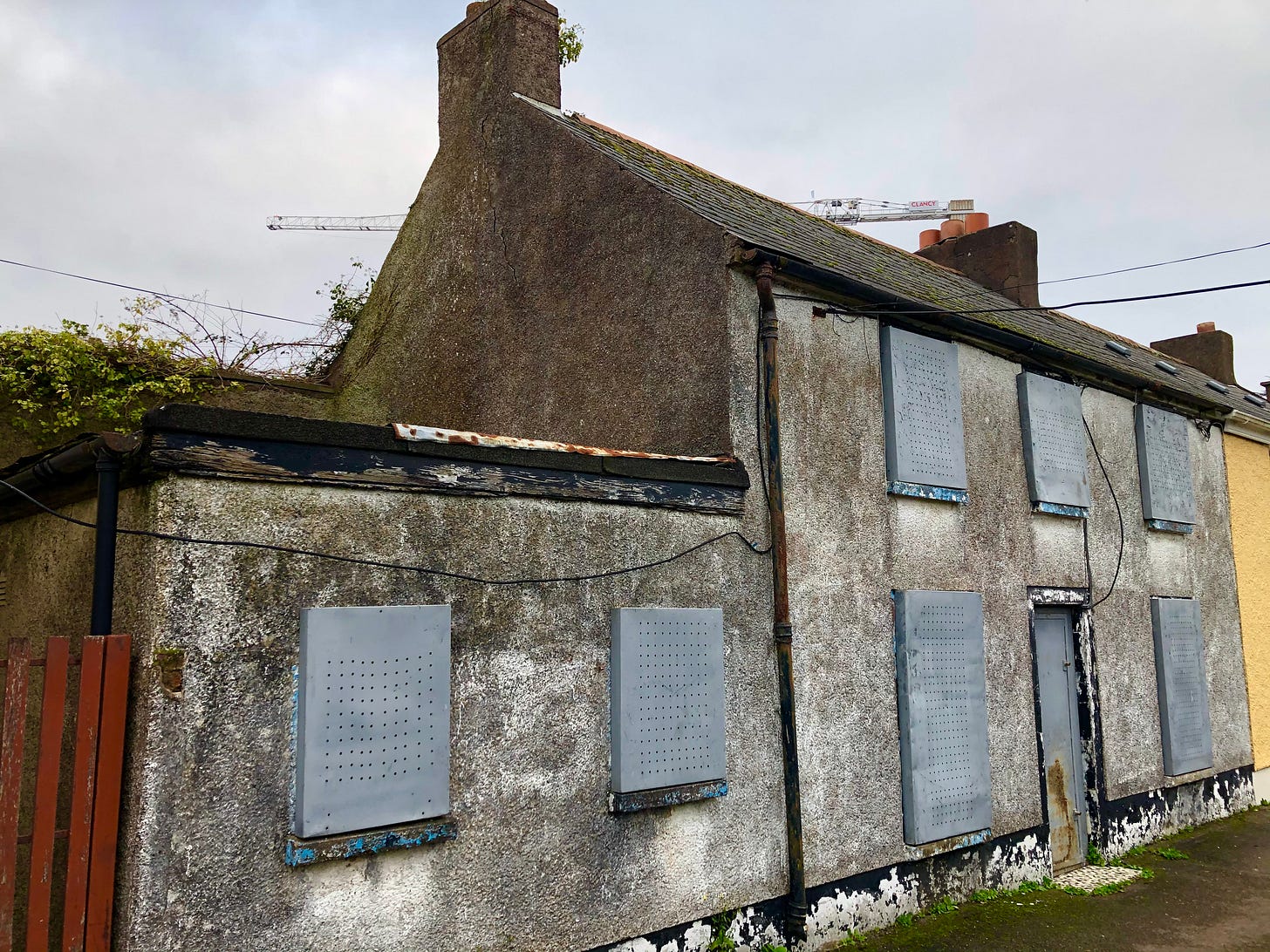
A timeline
The below timeline is derived from An Bórd Pleanála’s inspector’s reports from January 2018, compiled when Cork City Council were seeking a Compulsory Purchase Order on the building.
2002: The owner of the house, a Mr John O’Mahony, dies. Mr O’Mahony lived at 38 Gould Street prior to his death, but he also owned numbers 3, 3a and 15 Lough View Terrace.
2006: The council’s Planning and Development Department conduct an inspection of Lough View Terrace.
2007: Cork City Council’s Corporate Affairs contact the solicitors working for Mr O’Mahony’s estate. They begin to arrange the disposal of 3, 3a and 15 Lough View, Terrace, with the proceeds to charity, but there are “difficulties with title” for 38 Gould St. 15 Lough View Terrace will also ultimately also be CPOed by the council.
April 2010: A letter of complaint is sent to the council by the occupier of 39 Gould St, complaining of leaks and vermin at 38.
May 2010: The council’s Planning and Development Department conduct an inspection and decide the house needs to go on the Derelict Sites Register.
September 2011: The Planning Department issues a pre-section 11 notice of essential maintenance to be done to the building, to “the owner.” It’s unclear if this means to Mr O’Mahony’s estate via his solicitor or not.
October 2012: notice was served by the council that the properties would be put on the Derelict Sites Register
December 2012: 38 Gould St and 15 Lough View Terrace put on the Derelict Sites Register.
August 2015: the occupants of 39 Gould St again complain to the council about the dereliction.
September 2017: a notice of intention to purchase compulsorily is advertised in the Irish Examiner and served on Mr O’Mahony’s estate. Mr O’Mahony’s wife is also deceased and a Mr Edward Galvin from North Cork is left as the sole executor of the estate.
October 2017: Mr O’Mahony’s solicitors, Vincent Toher & Co, object to the CPO of Gould St and 15 Lough View Terrace.
January 2018: An Bórd Pleanála’s inspector visits the sites.
April 2018: permission for the CPO is granted to Cork City Council by An Bórd Pleanála. Permission is also granted for the CPO of 15 Lough View Terrace at the same time.
December 2021: there are no planning applications on file for 38 Gould Street or 15 Lough View Terrace.
The register is not the full story
Campaigners Frank O’Connor and Jude Sherry, who featured in our very first article here on Tripe + Drisheen and who have spent the intervening year fronting a highly successful national dereliction awareness campaign culminating in their appearance as expert witnesses before the Housing Committee of the Oireachtas this week, have always asserted that there is far more dereliction than the fluctuating number on the Derelict Sites Register, now at 93, reveals.


In fact, they say they have counted over 340 buildings they regard as derelict within a 2km radius of Cork city centre.
Niall acknowledges that there are more derelict houses than the register records; the purpose of the register, he says, is to allow local authorities to start charging levies in line with the Derelict Sites Act 1990, and to begin the process towards compulsory purchases instances where every effort has been made to get a property’s owner to take action and restore their building.
“There’s a huge amount of work behind the scenes in making sure houses don’t go on the register in the first place, to encourage owners to refurbish them,” he says.
Slow going
There are frankly astonishing lengths of time that some of the properties in council ownership have been derelict for, though. Niall says that statutory obligations and allowing for due process are the real stumbling block here.
“The process takes time, from when they’re placed on the register to when they’re compulsorily acquired,” he says.
“There is a series of stages you have to go through, even to identify the owners so you can serve notice under section 11 or section 8 of the derelict sites act so you can place them on a register. It might sound like I’m justifying it, but there’s a statutory process and you can’t place a property on the register unless you know who the owner is and who the levy can be applied to and who is responsible. It can take a lot of time despite all the resources and the best will in the world. From a statutory perspective it doesn’t become liable for acquisition until the following year.”
Jude Sherry does not agree; in her “10 deadly myths of dereliction,” she says the act provides for local authorities to make “reasonable effort” to identify the owner before placing it on the derelict sites register.
Human stories
When Jude and Frank appeared before the Housing Committee, Dublin City Council emphasised that the CPO process needed to be balanced against Ireland’s strong private property rights.
“There’s a narrative out there that there’s an unwillingness, but it’s not as simple as that,” Niall says. “This process takes a lot of time because you have to adhere to the statutory regulation, but also there are people’s property rights. We can’t go in and just take property. It doesn’t work like that; there’s no legal remit.”
Often for good reason. As Niall points out, the bulk of the properties on the derelict sites register are not owned by property speculators. While there are instances of hoarding or what appears to be tactical dereliction, this is not true of most of these properties.
How would advocates of a more aggressive approach feel if they had unwittingly pushed for a system change that disadvantaged mentally ill or elderly property owners?
“Particularly in the city, the small-scale properties are by and large not held by development companies who are jumping on the bandwagon with the vulture funds,” Niall says.
“You have families who own them. It doesn’t bear traction with the public, but behind every derelict site there’s a story and it’s never straightforward. There’s always a story, and we always have to act fairly and reasonably because when we’re challenged we can’t just have been acting unilaterally. We have to follow a process consistently and fairly.”
Cost
On top of this, there’s the cost to the local authority, in legal fees, man-hours and in the CPO process, before there’s even a shot at refurbishment.
“The council has to pay to value to the actual owner; we can’t acquire a property for zero, we have to compensate the cost of the acquisition,” Niall explains.
In 2017, Cork City Council reactivated a scheme to use CPOs on properties on the derelict sites register; Niall was actively involved in the process.
A pilot scheme
Five houses were successfully acquired, some of which had been derelict for more than 15 years.
Some were sold on the private market while others were renovated and used for social housing. The pilot programme was intended to show what could be accomplished by tackling the scourge of dereliction with an extensive CPO programme.
Here’s what has happened with some derelict houses acquired by Cork City Council between 2017 and 2020.
“Monaville” on Glasheen Road was acquired by agreement and sold on the open market and has been fully renovated.
Glasheen House, 1 Dorgan’s Road was acquired with the consent of An Bórd Pleanála in December 2017 and renovations have been recently completed.
No. 2, Ard na Rí Avenue, Pouladuff Road likewise was acquired with the consent of An Bórd Pleanála. The property is still in council ownership and will be used by council workers.
No. 15 Lough View Terrace. Acquired with the consent of An Bórd Pleanála in February 2018. The Council-owned property is still derelict.
No 38 Gould Street. Acquired with the consent of An Bórd Pleanála in April 2018. Still derelict.
1 Evenusville, Albert Road. Acquired by CPO in 2018/2019. Derelict and in council ownership.
However, the process is complex. Four owners appealed to An Bórd Pleanála and in one case, Ard na Rí Avenue, the owner took a High Court action which Cork City Council chose to fight: they won, but at a large financial cost.
“I was directly involved in those, in the time when I was in a property role with the council,” Niall says.
“We have failed in the acquisition of some properties that go before An Bórd Pleanála too, because we can’t show that we’ve given the owners sufficient notice to encourage them: you need to be constantly encouraging them to do something, and you need time to do it.”

Success stories: 5-6 Shandon St
Looking at a before-and-after images of the award-winning infill housing finished this June at 5 and 6 Shandon St is very satisfying to anyone who keeps an eye on city dereliction: a sensitive restoration has resulted in six housing units that Cork City Council are going to use as sheltered accommodation for elderly people.
Niall mentions them as a recent success story.
But even here, the public have been expressing frustration with the creakingly slow pace of actually getting residents into their new homes.
Six months after the official opening of the project, the ground floor apartments are clearly still vacant. It’s “in the process of being tenanted,” Niall tells me. After speaking to Niall I ask for a more detailed update from Cork City Council’s press officer.
Of six units, two have been allocated through the Choice Based Letting System and three others that are designed for tenants with medical needs have been allocated outside of that system, but not all of these tenants have moved in yet. They will be completed “this month.”
“We have had a refusal on the final remaining unit and we are in the process of selecting a replacement nominee,” the press officer told me in an email. “It is anticipated that the final unit will be allocated early in the New Year."
Disposal
There have been 10 CPOs since the pilot in 2017, Niall tells me. Of these, five were deemed suitable for social housing projects.
Another area where Niall would like to see more movement is in disposal of CPOed properties back into the private market. He points out recent successful disposals at Monaville and 98 Street; he says disposal to the private market can come with built-in checks and balances: making sure they property is bought by owner-occupiers, for example, or specifying no resale for a period of time.
There are political and ideological impediments to this approach in some quarters.
“Some elected officials would take the view that no property should ever be sold privately and that it should all be social housing,” he says. “We always assess to see if a property is suitable, but it’s not always the right approach and that slows things down.”
“We try to work with our elected members on that. Every property we acquire has to go through a section 182 disposal process to dispose of it to a third party and some councillors are very much opposed to that.”
“If there’s a greater appreciation of the scale of the problem and the need to tackle it, you’ll need to do that too, I believe; we’re not feathering the nests of developers, we’re taking on properties, cleaning up the title and putting them into the hands of the yous and Is who are out here looking for housing.”
Prevention is better than cure
A vacant homes officer is being secured for Cork City Council’s Planning Department for 2022. Niall believes this will have a knock-on impact on dereliction.
“Vacancy in many cases gives way to dereliction,” he says. “It’s the slippery slope, especially for older properties, which we have a lot of. It’s very hard to arrest that slide from long-term vacant into dereliction because costs spiral. So I think that early engagement in vacancy should offset some of the derelict sites problem.”
At the end of the day, Niall points out, the local authority is only one piece of the picture when it comes to ending the scourge of dereliction.
“It can’t be for Cork City Council to acquire every single derelict site,” he says. “First of all, it would be too costly and secondly, that’s not our role to do that in every single case.”
“It’s not sufficient in some people’s eyes, but from the housing department’s perspective, us getting involved in dereliction and bringing back significant numbers of new units, which is essentially what we like to do, is a part of the answer. Not the whole answer, but a part of the answer.”





